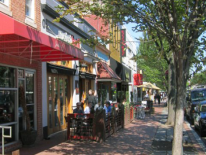
Neighborhood Participation in Toolkit Application and Technical Assistance Program
The DC Office of Planning (OP) has issued a Request for Qualifications (RFQ) for neighborhoods interested in participating in the DC Vibrant Retail Streets Toolkit workshop and technical assistance program. Working with its consultant, Streetsense, OP will hold customized workshops in Spring 2013 designed to help selected areas throughout the District apply the retail diagnostic assessment and the Toolkit to retail streets. After the workshops, two technical assistance sessions will be held with each community. The workshops will also leverage the Toolkit’s research on best practices, metrics, and innovative approaches for successful management of commercial districts. Information on the RFQ, including how to apply, is available at Vibrant Streets DC.
Background
The DC Vibrant Retail Streets Toolkit provides a framework for retail streets in the District to truly thrive by stimulating greater and more innovative collaboration among retail stakeholders, supporting retail entrepreneurs, and ensuring shoppers have a greater selection of products and services. The Vibrant Retail Streets Toolkit is designed to take advantage of renewed interest in urban markets by retailers as well as District assets such as walkability, sustainability and urban form.
The Toolkit incorporates research on best practices and innovative approaches to managing successful commercial districts and also uses retail metrics that assess the level of retail demand, accessibility, location, mix and format. The study offers guidance on key retail issues such as retailers’ site location considerations and decision-making processes, as well as how neighborhoods can measure, gauge and spark retail vibrancy through a diagnostic assessment. The analysis and toolkit is intended to equip retailers, landlords, business and neighborhood associations, nonprofits and government agencies with the tools needed to support more dynamic retail streets in the District. The study was undertaken in the context that the District’s evolving retail economy is an opportunity for the city to grow its tax base and become more fiscally sound.
Highlights from the Toolkit
- Retailers seeking urban locations are increasingly relying on transit and pedestrian counts as a measure of how accessible and visible a potential location is to customers.
- A critical element of a successful vibrant retail street is an active merchants’ or business association, community group, or non-profit organization to offer clear leadership and to unify the disparate interests of individual tenants.
- The presence of a civic or cultural use (i.e., a post office, park, church, or school) makes a significant contribution, as it creates a “non-commercial” reason to participate in the activity of a vibrant street.
- Extremely high residential density, income or workforce population can convince a retailer to overlook other factors or shortcomings.
- Vibrant streets have a perception of safety through pedestrian-oriented lighting, residential units on the upper floors, continuous storefronts, and sidewalks that are litter and graffiti-free.
- With a relatively small amount of information, urban neighborhoods can assess their ability to attract different types of retail establishments and focus their attraction efforts accordingly.


